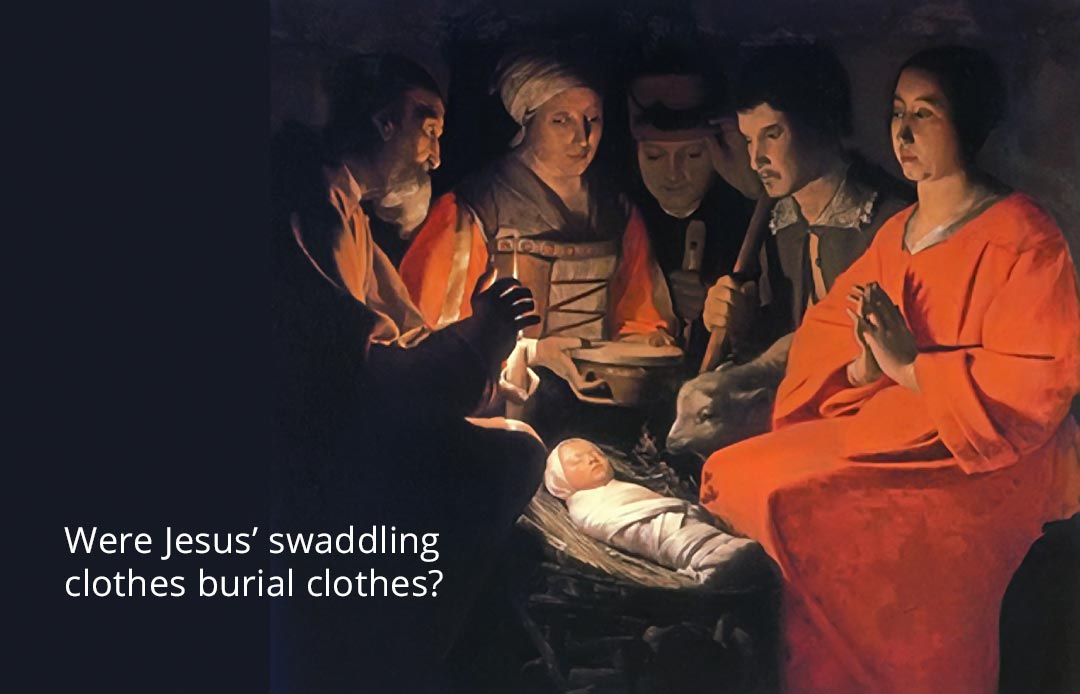Bible Question:
Is it true that the reason “swaddling clothes” would be “a sign” to the shepherds was because the original word for swaddling clothes indicates grave clothes often stored in a tomb? A sign of Jesus' future?
Bible Answer:
When Jesus was born, Luke 2:7 tells us that He was wrapped in “swaddling clothes.” There are many wrong ideas floating around regarding the meaning of swaddling clothes. Some have claimed that the term “swaddling clothes” indicates that Jesus had a illegitimate birth. He was born before Joseph and Mary were married. Others claim that the Greek word translated in Luke 2:7 and 12 as “swaddling clothes” is the same word used for burial clothes and therefore really refers to burial clothes or a burial cloth. However, neither of these positions are accurate and they are not supported by the evidence.

Meaning of the Greek Word Swaddling Clothes
The phrase “swaddling clothes” is a translation of the root Greek word sparganoo. The word appears in only two verses in the New Testament, both times in Luke 2. The first appearance of sparganoo occurs in verse 7 and the second is in verse 12. The Greek word sparganoo means “to wrap a child in swaddling clothes (long strips of cloth)” or “to clothe in strips of cloth, to wrap up in strips of cloth, to wrap in cloths.”[1,2,3]
The Greek word sparganoo is never translated as “burial clothes” and never refers to a burial cloth in the New Testament. In the Koine Greek there were numerous words that refer to being clothed. Consequently, it is reasonable to discover that different Greek words described Jesus’ burial process. In Matthew 27:59 we are told that Jesus was wrapped in a clean linen cloth. The Greek verb for “wrapped” is entylisso which was used to describe wrapping up something such as a cadaver.[4] The Greek word that is translated as “linen cloths” in the verse is sindon. It means “linen cloth of good quality.”[5] The same two Greek words, entylisso and sindon, are used in Luke 23:53 to describe the burial process for Jesus. Then in Mark 15:46 we are told that Jesus was “wrapped in the linen cloth.” The Greek verb for “wrapped” is enieleo which means “to wrap in.”[6] The Greek word for cloth is once again sindon. In John 19:40 we are told that Jesus was “bound in linen wrappings.” The Greek word for “bound” is deo and the word for “linen wrappings” is othonion. Deo means “to bind”[7] and othonion refers to a piece of fine cloth.[8] All of this reveals that sparganoo was not used to describe Jesus being wrapped in His burial cloths.
Sparganoo also appears in the Septuagint version of the Old Testament in Ezekiel 16:4. Here is the verse,
As for your birth, on the day you were born your navel cord was not cut, nor were you washed with water for cleansing; you were not rubbed with salt or even wrapped in cloths. Ezekiel 16:4 (NASB)
In this verse sparganoo is translated as “wrapped in cloths.” It is clear from the verse that sparganoo refers to baby clothes and not burial clothes. In Ezekiel 16:2 we discover that the citizens of Jerusalem are the focus of this message and God refers to the time of their birth (Ezekiel 16:1-4).
Therefore, the Greek word sparganoo refers to clothes that a baby would wear. The word sparganoo means “long strips of cloth for infant care” or “wrap in baby clothes.” It was a word that appeared in ancient medical writings.
Significance of Sparganoo
Luke 2:12 tells us that when the angels appeared to the shepherds at night, the sign identifying the infant Jesus as the Messiah was that He would be wrapped in baby clothes – sparganoo. Historical records reveal what was significant about these clothes. It was common in ancient times to not put what we would call diapers on the baby. Often very young children would be allowed to walk about without under garments..[10, 11] Most often it was the more affluent who had the resources to afford undergarments for their children. Since Mary and Joseph were on travel journeying the town of Joseph’s ancestors at the time of Jesus’ birth, it is possible that people of means gave Mary some clothes for Jesus. What is really significant is that Jesus was also in a manger – an animal feeding trough. The baby Jesus lying in an animal trough and ironically wrapped in clothes fitting for the wealthy would be an incredible sign to the shepherds.
Conclusion:
Jesus was wrapped in cloths as a sign that He was special and that He was the King of kings. The significance of his royalty should never be diminished (Rev. 19:16).
References:
1. Lou and Nida. United Bible Societies. New York. 1989. p. 526.
2. Danker and Bauer. Greek-Lexicon of the New Testament and Other Early Christian Literature. The University of Chicago Press. 2000. p. 936.
3. Liddell and Scott. Greek-English Lexcon. Oxford Press. 1996. p. 1624.
4. Lou and Nida. Ibid. p. 72.
5. Ibid.
6. Ibid. p. 702.
7. Ibid. p. 222
8. Ibid. p. 72.
9. Ceslas Sicpq. Theological Lexicon of the New Testament. Hendrickson Publishers. 1994. p. 564.
10. Waiter L Liefeld. Luke. The Expositor’s Bible Commentary. Regency Reference Library. 1984. p. 846.
11. John MacArthur. Luke 1-5. The MacArthur New Testament Commentary. Moody Publishing. 2009. p. 160.
Suggested Links:
The Rescue -SalvationJesus Is Born